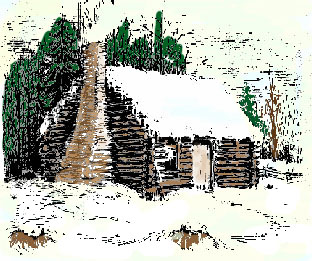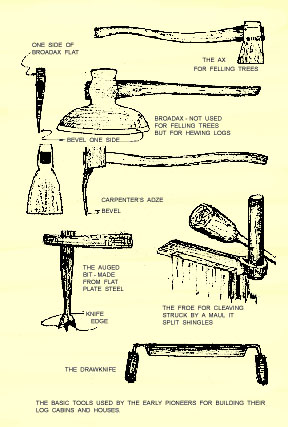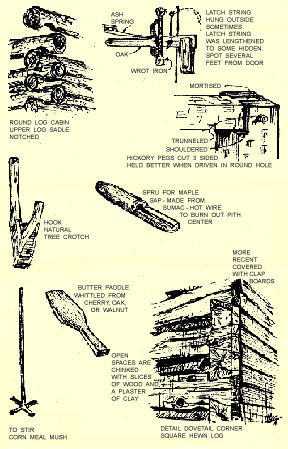|
LIFE IN A LOG HOME
By Onieta Fisher Illustrated BY William Wagner
Page 1, 2, 3, 4, 5, 6, 7, 8, 9, 10, 11, 12, 13 |
|
1 |
What
was it like to live in a log cabin? Now, we
can let our family move into their furnished home. |
| 2 |
What time is it? Or perhaps the sun is not shining. It has been drizzling and raining off and on for nearly a week. (You know how Iowa weather is, sometimes.) Everything is wet, or at least damp, including clothing and boots and bedding and firewood‑and the babies. The picture is beginning to emerge. It is too late to ask Ma or Pa what it was really like to live with a dozen others in one middle‑sized room, but there still are old people who remember things their parents told. This is a record of those observations. Rankin Young, now of Cleveland, Oklahoma, relates this information from the history of the Young family in Washington County, Iowa: Grandfather John A. Young's home was the stopping place for the preachers. Sometimes more than one preacher would stop over night on their way to and from Conference. Yes, it was my father, Charles Wesley Young, who was delegated the task of caring for the minister's horse and sleeping with him during the night. Not particularly an occasion to be looked forward to by a teenage boy. The older boys refused the compliment. My father, being a little more amenable to parental suggestion, submitted to the ordeal.
When one stops to
consider that there were eight or nine children and sometimes
hired‑help in the home, it is not surprising that it might be
necessary for someone to sleep with the preacher." |
| 3 |
Since hospitality was the order of the
day, we would expect the "crowded" conditions to be the rule rather than
the exception. First, there is a difference between a log cabin and a log house. Cabins were cruder, built with round logs having most of the bark left on. The log house was a more "finished" structure, made of logs hewn "square" with the adze and broadaxe. The adze blade was set on its handle somewhat as a hoe is. The woodsman first "chopped" notches in the top of the log, then turned it to the side. The broad axe was used to slice off the uniform cuts made by the adze. The finished log was more rectangular than square, its depth or width depending upon the original tree and tapering somewhat from the butt or wide end. This made one end slightly wider than the other; so in building the walls, the big ends of the logs were turned first one way and then the other to keep the walls level. The logs were fitted together at the corners by means of notches and saddles. These joints were cut at a slant so that the rain drained off instead of soaking in to cause decay. Nails were not used in log structures. Large wooden pegs or trunnels (tree nails) were used to secure timbers and the frames of the door and windows, hinges, and so on. The hinges might be made of wood, or leather; but by the time Iowa was being settled, iron hardware was available, often being made from strap iron in the pioneer's own "shop." The very earliest settlers sometimes burned their cabins to retrieve the hardware as they moved on farther into the wilderness. Hangers for clothing or harness were made by inserting a peg into a hole bored in the wall, or by nailing a forked stick in a handy place. Windows and doors were cut after the walls were up and short "blocks" of logs were cut for the ends to rest on. Open spaces in the walls were chinked with long wedges split from logs, like uneven slices of bread. Clay and sand or grass mixtures were plastered over them to keep most of the weather outside. |
| 4 |
|
| 5 |
|
| 6 |
Early homes were set true to the compass to help the pioneers keep their directions straight, particularly on the prairie where there were few landmarks and where, on a cloudy day, it was easy to become confused and lost. The door was "to the south" to let in light and to mark the passage of time as the sun moved a shadow farther and farther along the floor. Walls were usually "seven logs high" to the loft or cross beams, with a couple more for head space in the area. Rough boards from a sawmill, or crude ones split from logs, made the floor of the loft, providing sleeping space for the overflow from the "pallets" around the fireplace. If there was a pole bed in the corner, it might be shared by Pa and Ma (with Ma in the middle) and her sister who was "that way" and thus merited the comfort of one‑third of a bed. A log house which might be considered typical recently began a new life. This is the Glenn Sakulin house which was used in the reconstruction of the storehouse at old Fort Des Moines. The Sakulin house was 20 by 18 feet, with (iii inch thick hewn oak logs. It was built about 1840, in Richmond. Iowa. Some time later, probably about 1880, the original log home was used as the frame for a new house made of boards. In 1982, the logs were rediscovered and incorporated into the Birthplace of Des Moines project. At that time, the old logs were found to be so hard that thumb tacks and roofing nails broke off when they were driven in to mark the logs. Was wood different back in the 1840's? The Department of Forestry at Ames says that the trees cut by the earliest settlers had grown, perhaps for centuries, on virgin soil rich in the elements that produced lumber of superior quality. Instead of deteriorating, as our later growth timber does, it actually seemed to harden with time. A well‑constructed log house would have been relatively comfortable, with its thick walls and its close‑to‑the‑earth design. No doubt much of the heat from the fireplace escaped up the chimney on windy days, and rainy spells must have been tiresome. Body heat helped to keep the numerous occupants warm. But the pioneer homemaker was not concerned with the temperature inside her house. She had other things to occupy her thoughts. |
| 7 |
Great‑grandmother really knew the meaning of "togetherness." Bad weather brought the men, the children, the relatives, the in‑laws, the preacher, and perhaps a tin peddler, inside. The men worked with their hands, making or mending things‑harness, tools, furniture. They talked and argued, or slept and snored. For the women there were the usual household tasks, possibly game to dress and prepare for cooking, and always keeping an eye on the babies to see that they didn't get too near the fire. There was sewing and mending to be done and what a bother it was to lose or break the last good needlel How did the children spend their time when they were house‑bound? The older ones played with the babies, amusing them by tossing and blowing a feather into the air or by playing catch with a rabbit's fluffy cotton tail. They watched the men as they cleaned their guns or poured lead bullets. They cracked and ate nuts and poked their fingers into the bread dough or into the cream on the crock of milk. The boys teased the girls, or perhaps they curled up in a corner with a favorite dog and listened as the men discussed politics or spun yarns about how it used to be when they were tykes. Sometimes, the first "school" was taught by the mother or an aunt in the midst of such varied activities. A blackened shovel made a good slate; so did the hard packed earth of the floor, or the frost on the windows. There were homemade games like checkers, and doll‑babies made of whatever was available. For the boys there was the great outdoors and the possibility of stalking a wolf, regardless of weather; and the very real hazard of getting lost in the big bluestem, taller than a man. |
| 8 |
No matter how many were under foot, the cooking had to be done. Its preparation depended upon what was available. Game was abundant; fruits and vegetables were seasonal; crop produce could be stored in root cellars, dried, or preserved. Turnips and carrots, pumpkins, potatoes, apples, berries, nuts and pork gave some variety but meal was the mainstay. Cornmeal was made from white corn, sometimes yellow or even red. Cornbread, or mush were staples on the menu. Mush was put on to cook by mid‑afternoon. Buckwheat was a quick‑growing crop which could be planted late and still have time to mature. The meal was used for pancakes. In November, 1959, a recipe for old fashioned buckwheat cakes was given in the Des Moines Register: It is repeated here, by permission of the editor: * "Pour 1 pint of warm water into a large pitcher or crock. Add 1/2 package of dry yeast; 1 teaspoon of sale and 2 tablespoons of dark molasses. Then add enough buckwheat flour to make a thin batter. (Scant 2 cups.) Cover the pitcher and let stand in a warm place over night (or all day). In the morning, beat the batter down and add 1 teaspoon soda dissolved in a little warm water. Bake on a greased, hot griddle, drench in hot maple syrup or honey and start eating. Boy!
These are the real,
genuine buckwheat pancakes. You can keep the batter "going" for a long
time. Save 1/2 cup of batter in the refrigerator and use it in place of
the 1/2 cake of yeast for the new batch. Proceed as for first time. |
| 9 |
The cakes get a bit tangier as you go alongi and we like that bit of sourness, but some epicures prefer to make a new batch each time." Use plain buckwheat flour, not the self‑rising ready‑mix. Apples were peeled and dried, later to be soaked and cooked with a little honey or sorghum. William Jones of Washington remembers that his mother put down crab apples in sorghum, probably thinned with vinegar and spiced. Fried, dried‑apple pies were a welcome addition to the menu. The cooked and sweetened fruit was placed on a small round of pie dough and the edges sealed like a turnover. The pies were then fried slowly in a heavy iron skillet, first on one side and then. on the other. Mr. Jones told about a wintertime confection their family liked. Parched corn and nutmeats were ground up and mix‑ with a boiled syrup made of sorghum and butter, somewhat like cracker‑jacks. The latter was made by cooking sorghum and butter in a heavy skillet until it "spun a hair." The syrup was poured over popped corn, stirred, and spread out to "crisp." (Use 9 cup sorghum, '1 cup corn syrup, 1 tablespoon butter, pinch of salt, to a couple of batches of popcorn.) Pork was almost too plentiful and early settlers suffered from a steady diet of it. It might be salted down and smoked, or "fried down." Or it was used fresh, often by sharing and exchanging with neighbors. The boss of a crew of men working on construction jobs might buy a whole hog and have it "fried down" for the use of the camp cook. The sliced or ground meat was fried, packed into jars and covered with melted lard or "fryings." In this way, the meat "kept" during warm weather. Beef was less common. Not only was the meat enjoyed, but also the tallow was valued for candle‑making. A portion was dried behind the stove or near the fire, after first being cured and smoked. It became so dry and hard that it could only be chipped off, giving the familiar name to our "chipped beef" gravy. |
| 10 |
It was a constant struggle to keep things half‑way clean. Earliest floors were the hard packed earth. Edith Helm Jones remembers a family who poured the dishwater on a different spot every day, to help keep the dust down. In time, the grease from the dishwater formed a fairly impenetrable wax-like surface. Crude brooms were made of buckbrush (coralberry) lashed together and trimmed evenly across the end. In some homes, dishwashing was simplified. After plates and bowls were washed the dishrag was "rinched out" and used to wipe the dishes, which were then set back on the table to dry.
The D.A.R. history of the Alex Young cabin in Sunset Park in Washington,
Iowa, states that, "During the Civil War, Alexander Young made a trip to
town daily |
| 11 |
A bangleboard was a small board, padded and covered with cloth. Hooks were spaced over the front to make a catch‑all for small articles‑bangles and beads, the key to a chest, the scissors‑anything small that could be hung up. The padded back served as a pincushion. Some of the floors were almost like pincushions. Those made of split logs were called "puncheon" floors, from a French word meaning "to prick." These floors often were so rough and uneven that only three legs of a chair would rest on the floor at one time, hence three‑legged stools. Cracks between the logs might be filled with earth, or they might serve as a spittoon for the men and women who chewed tobacco. The loft was for sleeping. Stairs took up space so the loft was reached by a ladder, sometimes crosspieces lashed to saplings, or crude steps hewn out of a log. If a young lady was vain enough to wear a hoop skirt, she had to lift the front of it when she attempted to negotiate the ladder‑stairs. There was little room for any but the most essential furnishings. Houseplants would have frozen. Curtains added charm but at the expense of light. Books were rare and precious. The home library, if there was one, usually consisted of a Bible, a doctor book, and an almanac. The almanac was almost indespensable for planting and harvesting "by the moon," and for keeping track of the passing days and weeks. If a little pioneer daughter picked a bouquet of wild flowers, she quite possibly put them in a whiskey‑bottle vase. Liquor was the most profitable means of marketing grain and it was therefore plentiful and cheap, from 12% to 25 cents a gallon. Hospitality was the common denominator in pioneer communities, but raiders and horse thieves were the bane of early settlers. They were more to be feared than the Indians or wolves. Even so, the latchstring was always out. |
| 12 |
|
| 13 |
However crowded the log house may have been, it still was better than the wagon‑life of the trail, or a makeshift lean‑to or cave. And no matter how many lived there this was not as bad as having to eat, sleep, and live in the same small room in which one member of the family might be dying. Life in log houses produced generations of hardy Iowans; we do well to remember them. |
|
|


